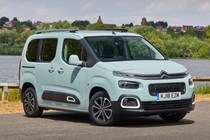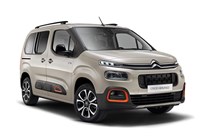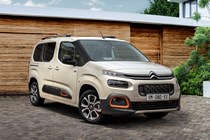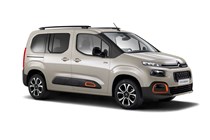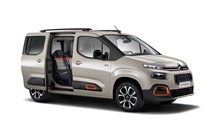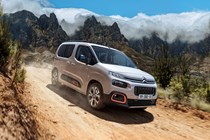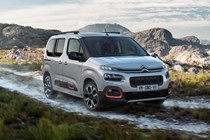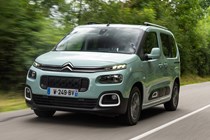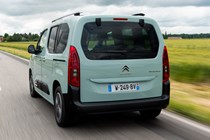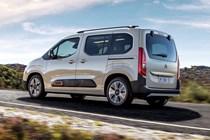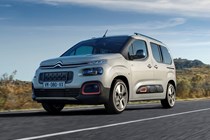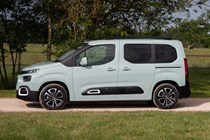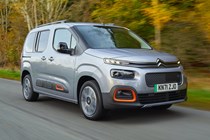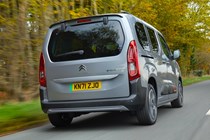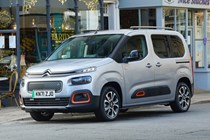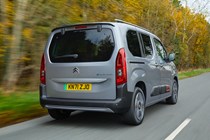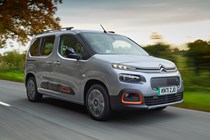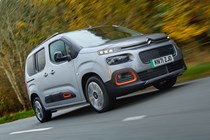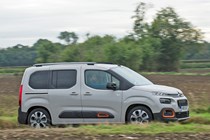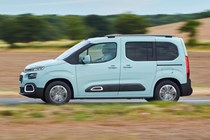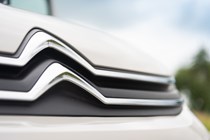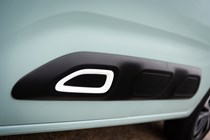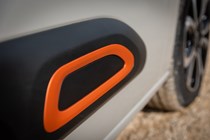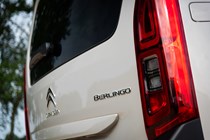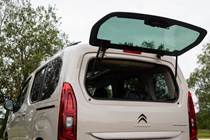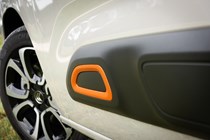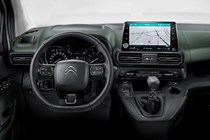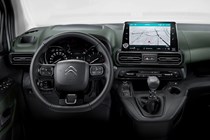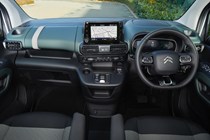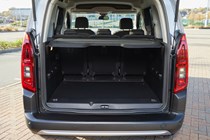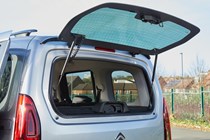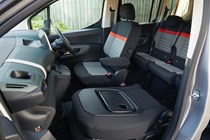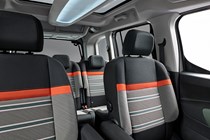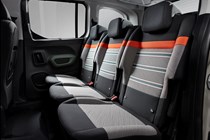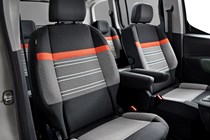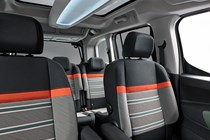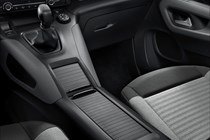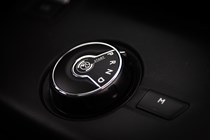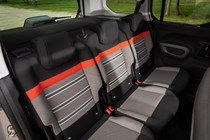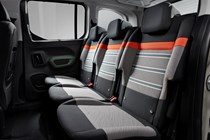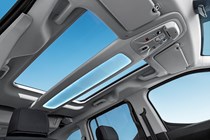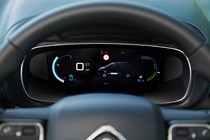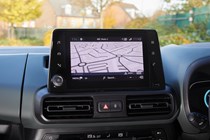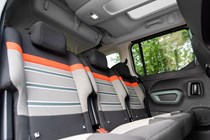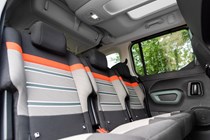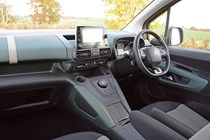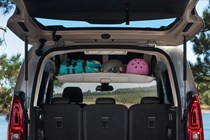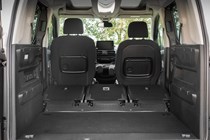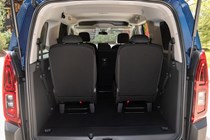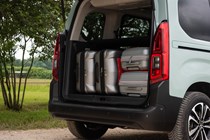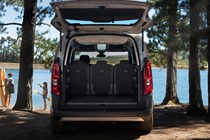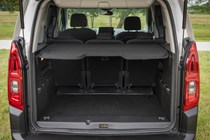
Citroën Berlingo long-term test

Update 1: Introduction to the fleet
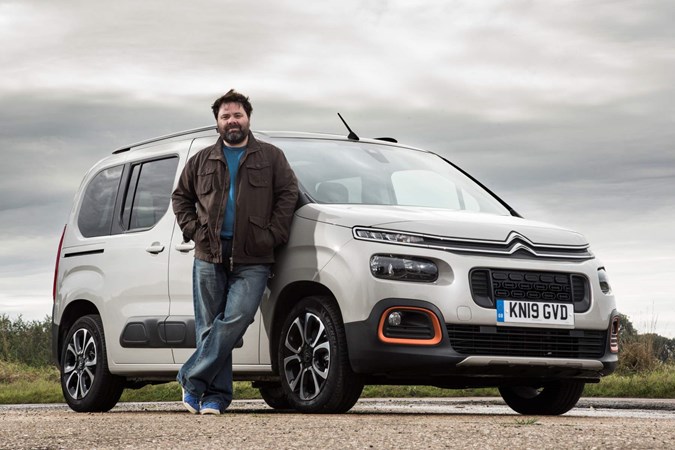
Okay, first things first. As indulgently tempting as it is to refer to this car alliteratively as the Beige Berlingo, that particular hue it’s enveloped in is called Soft Sand. Aptly, too, for when the sun beats heavily down upon it, the metallic flakes within glisten in a manner akin to facets of individual grains of sand on a beach reflecting light. That said, there’s no escaping that it looks decidedly flat when it’s cloudy.
It won’t have escaped your attention that I also referred to this Citroen as a car, despite its obvious van-based origins. A car is what it is, and a mighty fine one at that – so much so that Parkers awarded the Berlingo – along with its sister cars, the Peugeot Rifter and Vauxhall Combo Life – the Medium Family Car of the Year Award for 2020. I may have lobbied rather hard among my colleagues for the gong to go that way. There’s also a fourth variation, the Toyota Proace City Verso, but the Japanese brand’s elected not to bring it to British shores.
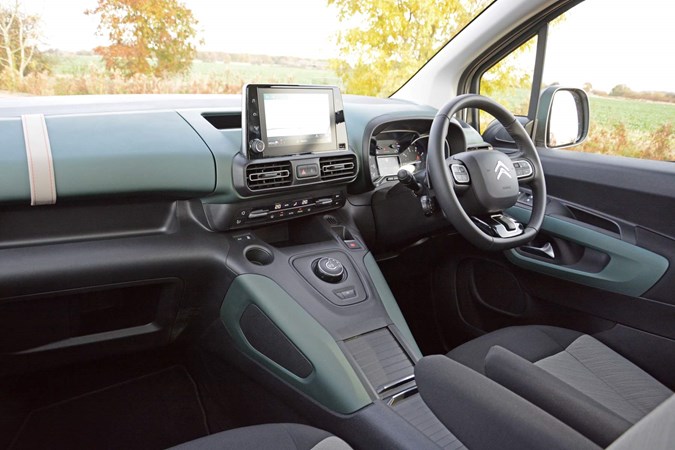
These commercial vehicle-based family ferries tend to be generically lumped together as MPVs, understandable given their inherent flexibility, seven-seater availability and the general decline of traditional ‘monovolume’ people carriers as the market craves less practical SUVs instead.
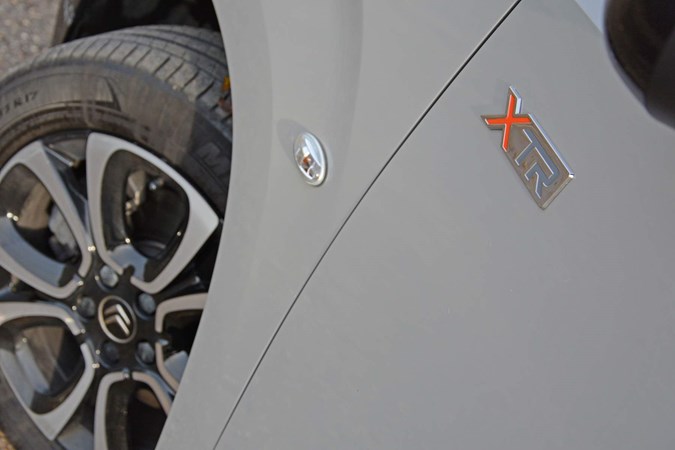
What would be more appropriate would be label cars of the Berlingo’s ilk as van-derived cars – or VDCs – a cause I’m happy to champion. Ping me a line on Twitter if you’d like to join a march on parliament for statutory recognition for a new class of car (or simply to say ‘I hear you, brother).
So, what’ve we gone for?
When VDCs first started gaining a foothold on the British market in the mid-to-late-1990s, they tended to be pragmatic choices, featuring little in the way of plushness or niceties one had become accustomed to with ‘ordinary’ cars. Tastes inevitably change, and just as today’s SUVs are no longer as complex to drive as church organs are to play, buyers of van-derived cars want their family-and-detritus-swallowing wagons to be ultra-practical and feature all the bells and whistles they’ve become accustomed to.
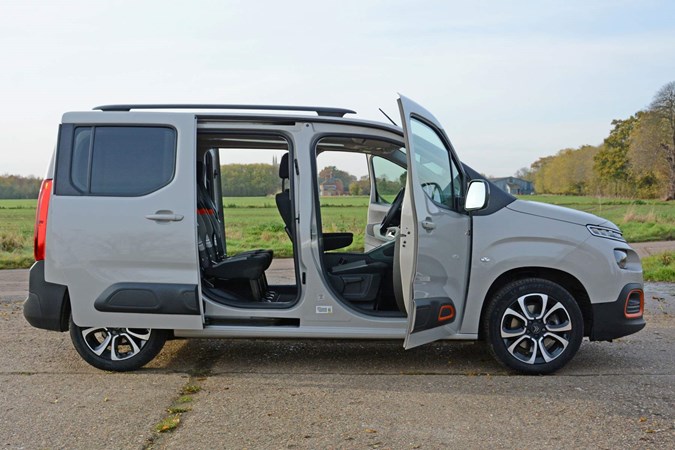
With that in mind, our Berlingo pairs the frugal-yet-adequately-punchy 1.5-litre BlueHDi 130 diesel engine, with an eight-speed automatic gearbox in range-topping Flair XTR trim. We’ve also opted for the shorter five-seater M-length body rather than the elongated seven-seater XL, primarily for aesthetic reasons – no laughing at the back.
According to the brochure, that powertrain combination results in a 114mph top speed and a 0-62mph acceleration time of 11 seconds. That sounds leisurely, but in reality the Berlingo feels a bit brisker than that – you’re unlikely to venture down a motorway sliproad sweating with trepidation. Official claims of 45.1-50.3mpg on the newest WLTP test cycle seem to closely match what we’re achieving so far, in the mid 48s. Not bad at all.
Operating the eight-speed autobox is a doddle, with a very straightforward rotary knob to switch between P, R, N and D. If you’re so inclined – I rarely am in anything other than sports cars – there are steering column-mounted paddles to flick manually between the octet of ratios.
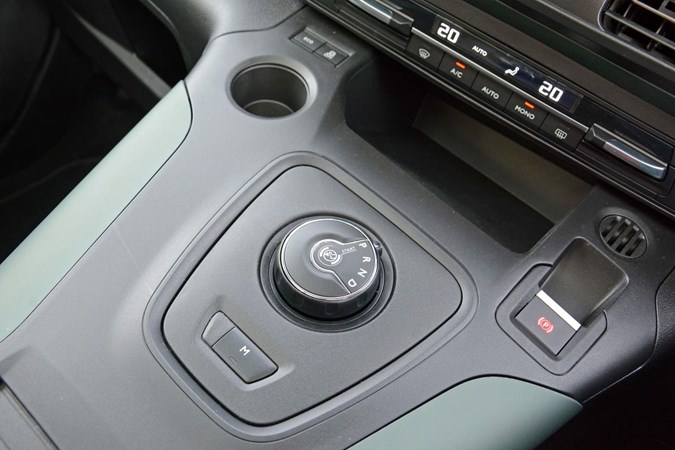
Most shifts are smooth and perceptible only due to changes in engine note rather than via jolts through the car itself, but when crawling along at urban speeds the stop-start’s keenness to starve the engine of diesel can cause it to abruptly halt your 3mph creepalong at traffic lights.
Flair XTR: the lowdown
With its ever-so-slightly elevated ride height, skid plates on the bumpers and orange exterior accents, the Berlingo Flair XTR’s got something of an SUV vibe about its looks – certainly not as overtly so as its Rifter cousin, which comes complete with wheelarch mouldings and lower-body cladding – but enough to make it less utilitarian.
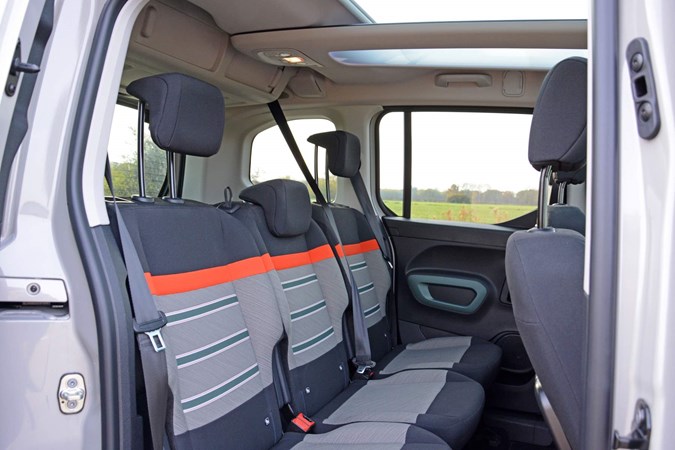
It’s even more of a hoot inside with a green, rubbery finish to the dashboard and door mouldings, together with a green and orange striped seat trim. It feels very Gallic – it’s not hard to imagine Pascal, your French teacher’s exchange student, wearing a similarly patterned polo shirt teamed with too-short skinny jeans and espadrilles.
Lifting the ambience further, the Flair XTR also comes with:
- 17-inch black and silver Spin alloy wheels
- Gloss black door mirror caps and roof rails
- Dual-zone climate control
- Dark-tinted rear privacy glass
- All-round electric windows – even on the sliding rear doors
- Head-up display
- Modutop Roof with glazed panel and storage bins (look out for a forthcoming update on this)
- Separately opening tailgate window
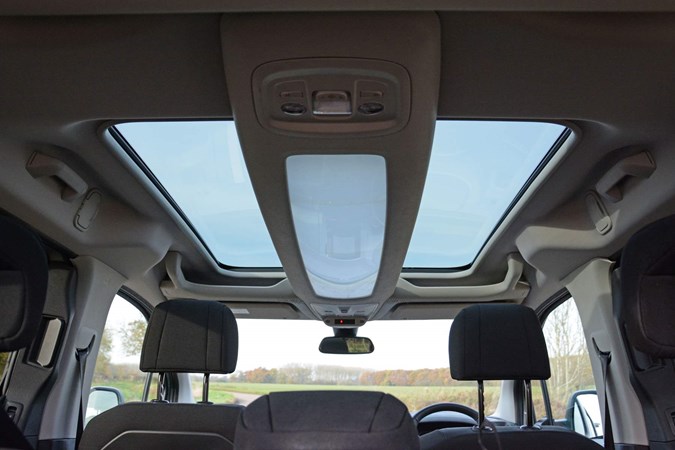
Models ordered now also come with keyless entry and start, as well as electrically folding door mirrors – these were options we decided not to go for when we ordered ours earlier this year.
All that weighs in at £26,810 on the road, but we’ve added a few trinkets from the extra-cost options list, including:
- Drive Assist Pack – comprises of traffic sign recognition, driver attention monitoring system, automatic main beam and adaptive cruise control with stop function – £200
- 180-degree reversing camera – £100
- High storage console between the front seats – £250
- Soft Sand metallic paint – £545
The result is a grand total of £27,905 – not exactly bargain family transport, but not a colossal amount for a spacious, practical, safe, economical and well-equipped medium family car.
Over the coming updates, I’ll be sharing what makes the Citroen Berlingo a persuasive choice for buyers considering migrating from a hatchback to a compact SUV, as well as highlighting any niggles that may surface along the way.

Update 2: Driving experience
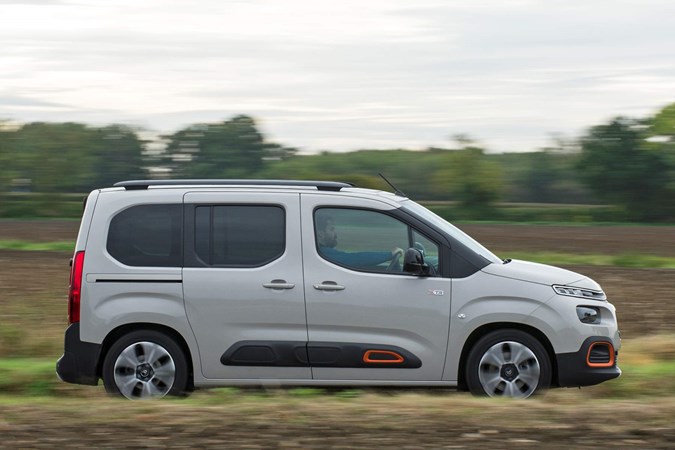
One frequent source of delight whenever I drive the Berlingo is how its performance and handling catch many a driver by surprise. Let’s be clear: I’m not suggesting the boxy Citroen tears up the rulebook in the same way Geoff Capes manhandles the Yellow Pages, but there’s a perception among many road users that cars of this ilk are ponderous at best and attempt to out-drive you accordingly. More often than not they soon become distant specks in the rear-view mirror.
So, what arrows does the Berlingo have in its quiver?
Gutsy diesel engine
You’ll occasionally read car reviews where the author suggests that it’s quicker than the statistics suggest, and this Berlingo is on
e such vehicle. Buried deep under that short flap of a bonnet is a 1.5-litre 130hp diesel engine that’s eager, but a tad loud at the higher echelons of the rev range. It’s certainly quieter in other applications, so that might be the Berlingo’s van origins coming to the fore.
Top speed is 114mph – not something I’ve attempted to confirm in a private test facility, I promise – but it definitely feels swifter than the 11-second 0-62mph suggests it will, particularly from a standstill to 30mph, making it very nippy around town.

Combined with its eight-speed automatic transmission, it picks up speed pleasingly when you’re already going at a decent pace. Transitioning from a 40mph road onto a dual carriageway is a task the Citroen’s very adept at: lift of the throttle momentarily before depressing it against the floor and the gearbox responds diligently dropping a couple or three ratios to assist with progress. Again, it’s a bit raucous as you mash the accelerator, but soon settles to a quiet cruise.
As suits its role as comfy family transport, the more gently you drive the Berlingo, the more relaxed – and quiet – it proves to be.
City driving frustration
As mentioned in the Berlingo’s introduction, driving in very slow speed traffic around town can prove frustratingly jerky due to the keenness of the stop-start system to activate itself, bringing you to an abrupt halt when you simply wanted to crawl at walking pace.
One method I’ve found of circumventing this issue is by employing my old friend adaptive cruise control at any given opportunity. When driven with this effective aid, the Citroen’s far less prone to suffering at the stop-start’s hands and instead will gently cruise up to the vehicle it’s following before sedately stopping.
Where Citroen could improve the system even further is by combining the electric parking brake with an auto hold feature. That way, when the car ahead moves again the Berlingo would simply get on its way automatically, or at worst, with a nudge of the accelerator pedal or cruise resume button. Instead you have to manually accelerate up to about 20mph before hitting resume. Not exactly a chore, but not as sophisticated as some rivals’ packages.
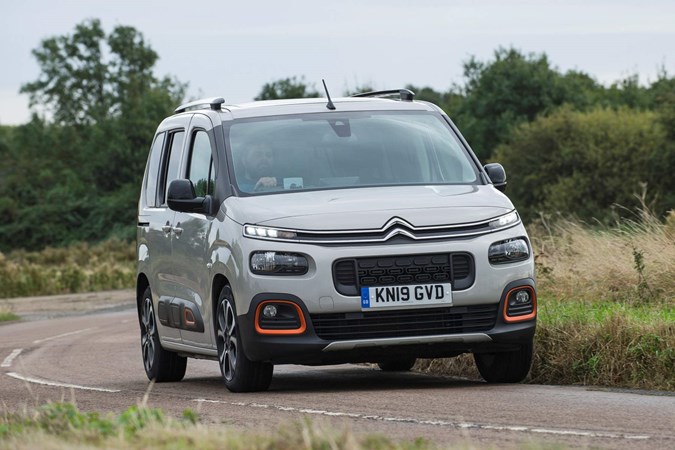
However, there’s a frustrating glitch in the Berlingo’s adaptive cruise system that means it can’t be used all of the time. For reasons hitherto unfathomed, occasionally the system decides it can’t ‘see’ the vehicle in front, in which case it doesn’t attempt to slow you down to maintain the gap – you just have to have your wits about you as you do with regular cruise control.
Even less frequently, it refuses to work altogether, yet have a go again a few minutes later and all’s well again. I’ll keep tabs on this and report back on progress.
Handle with care
No spoilers here: the Berlingo doesn’t handle like a sports car because it isn’t one. However, despite its height, its overall centre of gravity is low meaning that bodyroll isn’t exaggerated when you tackle corners at speed.
In fact, it’s rather tidy and will corner faithfully to the trajectory you’ve set it to, requiring minimal corrections to the steering angle. What it lacks is much in the way of feel through the wheel itself – that’s great for low-speed manoeuvres, particularly when the Berlingo’s loaded up with people and possessions, but gives little enjoyment back while driving on an interesting ribbon of road.
Nevertheless, it feels composed and planted, adept at cleaving its way through the air without being buffeted by cross-winds, nor losing traction readily when cornering quickly. Sure, drive like a hooligan and it will push wide – known as understeer – if you carry too much speed into a bend, but no more than it would in a competent family hatchback.
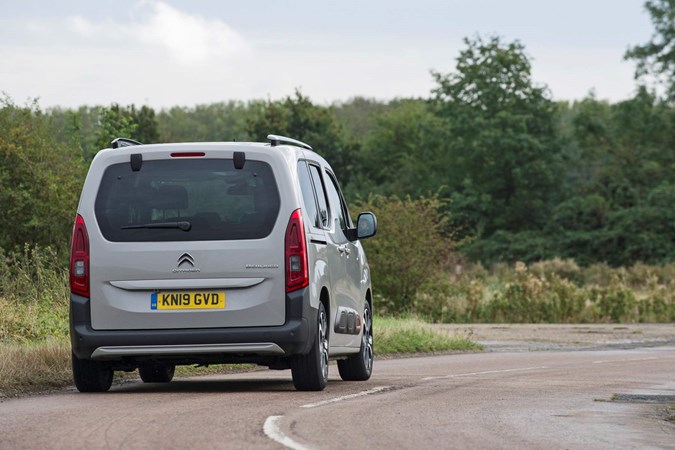
But overall, it feels nimble – just lacking in the sort of dynamic fairy dust that might otherwise have you considering a Ford Tourneo Connect. If that’s more important to you, then go for the one with the Blue Oval badge, but for us, the breadth of the Berlingo’s other talents mean it remains the one to beat.
Mileage: 1,814 miles
Fuel economy: 42.2mpg
Update 3: okay, it is a van – sort of
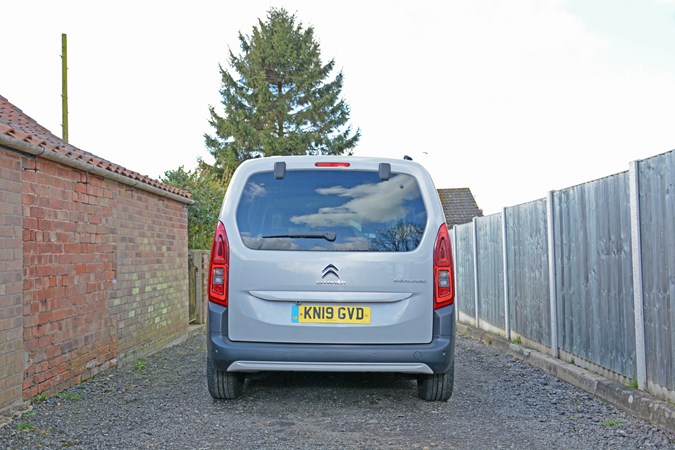
Perhaps the biggest disadvantage of driving a car like our Citroen Berlingo – and repeatedly hollering ‘it’s not a VAN!’ whenever the naysayers claim otherwise – is that from time-to-time there’s a need to haul something long and bulky about. Which, of course, means eating a generous slice of humble pie and turning it from a car into a, erm, van.
Alright, alright!! It’s van-ish – there is not getting away from that, but when you need to take advantage of such perpendiculariy, it’s reassuring to know that the interior’s fairly flexible without going all bare-metal-and-plywood-lined.
Easy access from the rear
Whereas dedicated Berlingo vans are most commonly fitted with asymmetrically split side-hinged doors at the rear, the car version has a top-hinged tailgate as standard. There’s no electrical function to open and close it, but the hydraulic struts make it feel light to operate and there’s a canvas strap to pull in to close it. One had yank usually does the job.
But, given the confines of many public parking spaces and home garages, there are many times when there’s simply not the room to open such an enormous door, which is where the optional opening tailgate glass is a godsend.
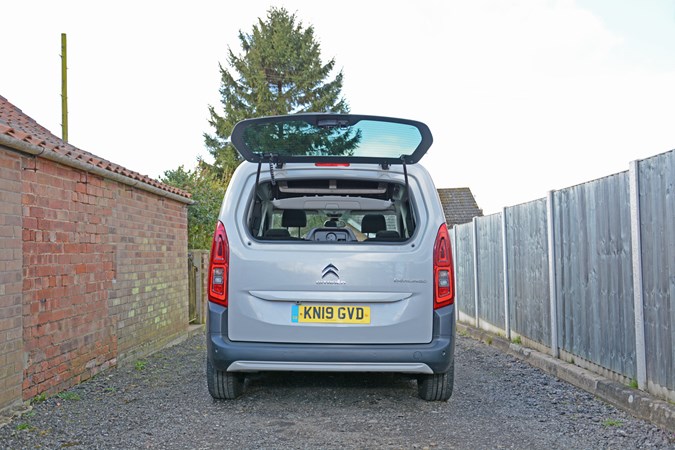
Operated via a separate release button to the right of the one for the main tailgate, it allows decent access, but picking something small off the boot floor can be tricky without partially inserting yourself through the narrow entry.
This is where the parcel shelf can play a part. Semi-rigid, with a bend in the middle to fold it out of the way, it can be slotted-in halfway down the height of the boot volume, with moulded ridges in the sides to hold it securely.

Plus, with the glazed Modutop roof pack – now standard on all Berlingo Flair XTR models – there’s also the handy drop down roof-mounted storage box for lighter packages.
Seating origami
Further enhancing our Berlingo’s flexibility is a trio of individual seats in the back, meaning you’ve a variety of options for carrying people and bulky stuff. That middle seat could even be used in isolation, but access would be a bit tricky as the rear footwells are occupied by the folded outer seats.
Operation is easy: simply push the plastic button on the outer pair – and the canvas loop on the middle one – and they tumble forwards in one seamless movement. Putting them back simply requires pushing the backrests up beyond the vertical position until they’ve locked into place.
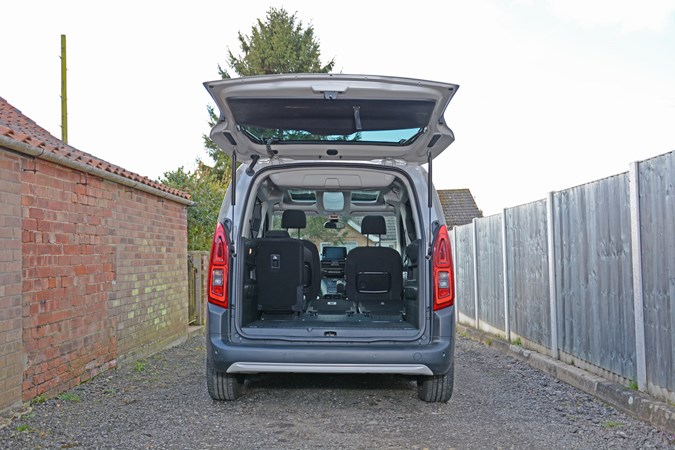
Newer Berlingos have release levers for the seats that are accessible from the boot, but it’s not much of a hardship going around the sides to the seats themselves.
My only gripe is that the boot floor isn’t completely flat, with the folded seats lying on a higher plane. There’s no unhelpful step, though, with plastic ramps at the back of the seat assembly to aid sliding heavy objects across the divide.
Single-seater cargo carrier
Where the Berlingo really comes into its own is that like its commercial vehicle cousin the seats can be folded in such a manner so that only the driver’s seat remains in use. Rather fundamental that it does, obviously.
Adjusting the backrest lever on the passenger seat means the whole seat folds forwards, but there’s a bit of chair admin to complete first.
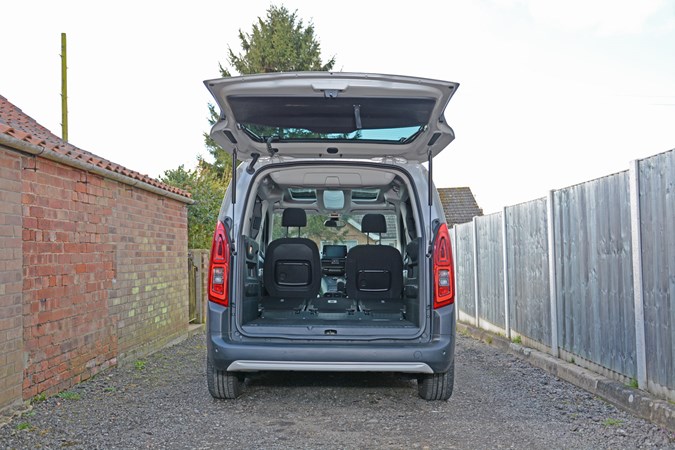
Not only does the headrest have to be removed – there’s space in the footwell, so you don’t have to look for somewhere to keep it once it’s taken off – but so does the fold-down armrest on the right-side of the seat.
It has to be removed otherwise it fouls the elevated storage cubby, but it’s not the easiest of tasks – imagine arm-wrestling Dwayne Johnson while he’s operating Gordon the Gopher and you get the idea.
Once down, the plastic shroud on the seatback makes sense as it too allows heavy objects to be slid across it, plus it’s more resilient than the fabric on the back of the driver’s seat.
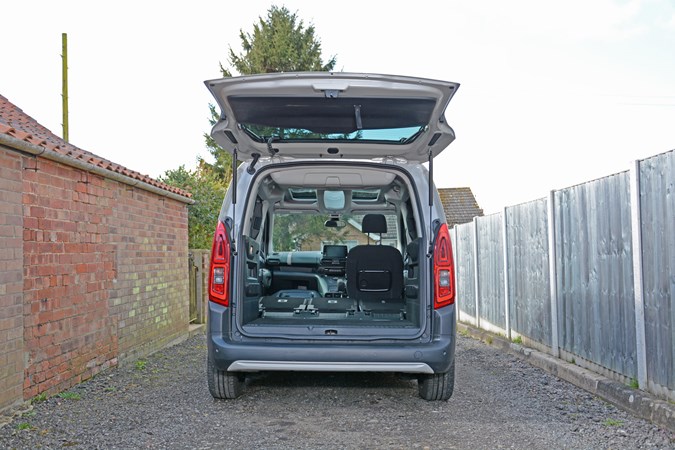
All in all, the overall carrying capacity jumps from an already impressive 775 litres in boot up to the window line to a, well, van-like 3,500 litres with four of the five seats folded forwards.
Your flexible friend
All of this voluminous practicality is a timely reminder of why the Berlingo – together with its Peugeot Rifter and Vauxhall Combo Life cousins – won Parkers’ Best Medium Family Car of the Year Award for 2020.
Such is the ease of which it can be converted from cavernous cargo swallower to family-friendly MPV makes it a car that’s so easy to recommend.
Not that my daughter was especially enamoured by the Berlingo’s charms when we went Christmas tree shopping in December… It’s all in the facial expressions, isn’t it?
Mileage: 4,628 miles
Fuel economy: 42.3mpg

Update 4: leasing costs explored
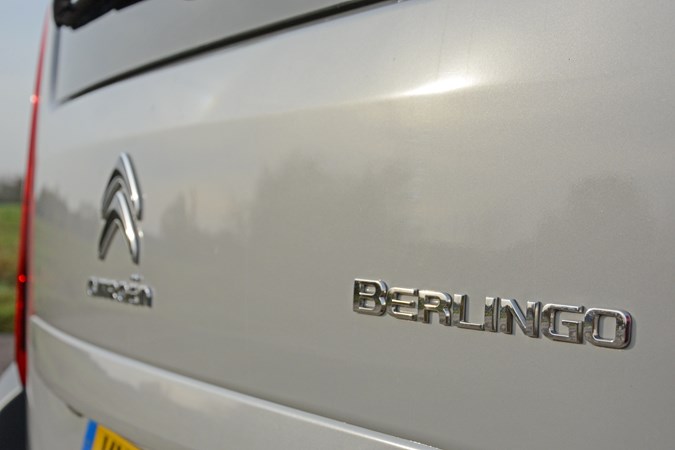
I treated myself to a holiday last week, which in these COVID-19-induced lockdown times means something different. Instead of being sat at my computer wearing joggers and a T-shirt producing words for Parkers and CAR Online, I was sat at my computer wearing joggers and a T-shirt poring over specification data for cars in the post-war years. You’re jealous, I can tell.
Despite being so effectively isolated from my normal antics, it was impossible to switch off entirely, especially when April’s anomalous sales figures were announced.
There was much social media excitement about this being a signpost that electric cars had properly broken through – the Tesla Model 3 and Jaguar I-Pace occupied the top two slots – but in reality, their numbers were tiny compared with how many Fiestas Ford flogs in a typical month.
Never-to-be-repeated nature of the numbers aside, what caught my eye more than the battery-powered pair were that there was a couple of van-derived-cars in the top 10: one of the Berlingo’s sister cars – the Peugeot Rifter – and its Ford-badged rival, the Tourneo Connect.
Was thinking time in lockdown making people re-evaluate the practicalities of their car choices or were there some astonishing leasing deals swinging the pendulum in their favour?
Berlingo vs rivals leasing costs
Scouring the leasing deals on Parkers didn’t immediately shed any laser-focused illumination.
At £235 per month, the cheapest Rifter is £1 more than the least expensive Berlingo, while the other family member – Vauxhall’s Combo Life – is a touch more at £242 per month.
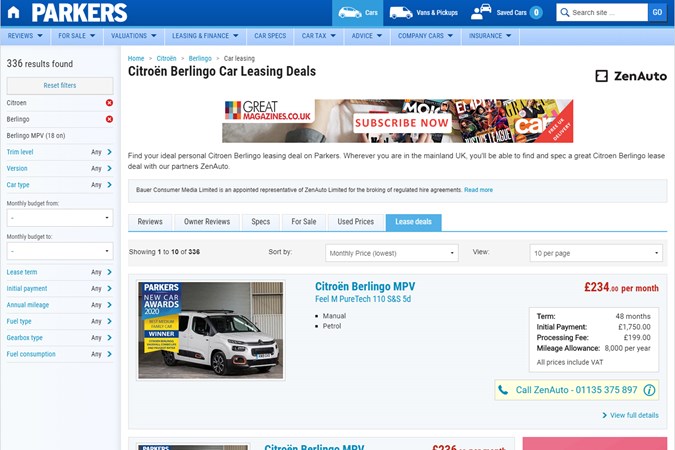
All of those packages are through Zen Auto and are 48 months long, require an initial payment of £1,750 and a processing fee of £199. Plus, you’re capped at 8,000 miles per annum.
It’s also worth noting that all are for the cheapest, least-well equipped trim levels, with the least powerful 100hp diesel engine in the Peugeot and Vauxhall, or the sweeter 1.2 110hp petrol in the Citroen.
If you fancy the same diesel engine in the Citroen, it nudges up by £2 per month, to £236.
In isolation – no pun intended – those figures are much of a muchness, so how do they compare with the Blue Oval’s alternative?
In the Ford’s favour, the cheapest Tourneo Connect has a 120hp diesel engine, so it’s a bit punchier, but over the same 48-month period, limited to 8,000 miles per annum, it’ll cost £309 per month – that’s £3,600 more over four years than that least costly Berlingo.
Plus, with the initial payment on the Ford being £500 higher in the first place, that comes out at £4,100 more in total – not such good value.
Top-spec Berlingo beaten by Rifter
What about at the plusher end of the scale for this kind of car? After all, our long-term Berlingo is in range-topping Flair XTR trim, fitted with the 130hp diesel engine and an eight-speed automatic gearbox.
Over the same 48-month leasing period, with an identical 8,000-mile allowance, a top-flight Citroen Berlingo will set you back £295 per month, plus a £2,000 initial payment and a £199 processing fee.
Peugeot’s nearest equivalent Rifter, with the same engine and gearbox combination in GT Line trim is slightly cheaper £290 per month, with all other costs and conditions being equal. That’s £240 less than the Citroen over the terms of the agreement, enough for five or six tanks of diesel.
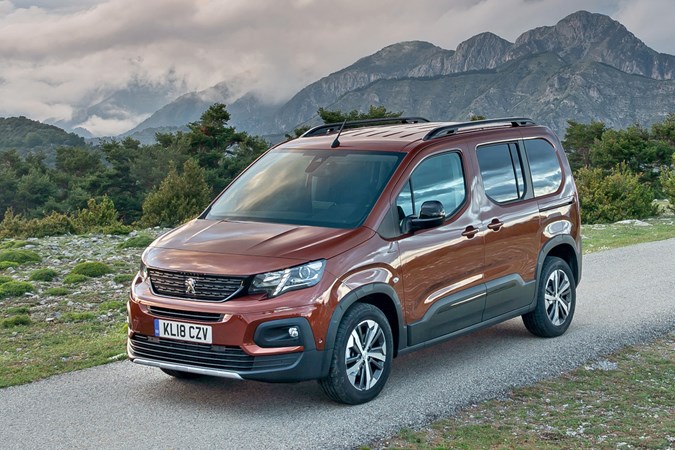
What of the Vauxhall? The same engine/transmission pairing in the Combo Life with gussied-up Elite trim is not such a cost-effective option.
With the term length, mileage allowance and processing fee all identical, not only does the initial payment creep up to £2,250, the monthly bill is harder to swallow at £322 per month.
Over four years you’ll have spent £1,546 by going for the Vauxhall over the Citroen.
Still tempted by a high-spec Ford Tourneo Connect? You’ll still be stuck with that 120hp diesel, but now with an eight-speed auto and Titanium specification. With the same terms and conditions in place, the initial payment rises to £2,500 and the monthly amounts to £348.
By the time four years have passed, the Ford will have cost you £3,044 more than the Citroen.
Berlingo vs C5 Aircross leasing cost
While in those instances the Berlingo seems decent value, and the Rifter slightly more so, I’m minded of my colleague CJ Hubbard’s recent piece about the astonishing value for money when leasing a seven-seater SEAT Tarraco.
In Xcellence trim, with a brisk 150hp petrol engine and automatic gearbox, the SEAT costs just £239 per month, albeit for a two-year deal, with a £2,000 initial payment, plus £199 processing fee.
But given it’s an SUV and knowing how buyers are flocking to them in droves, made me wonder how the Berlingo compares with Citroen’s larger SUV offering, the C5 Aircross.
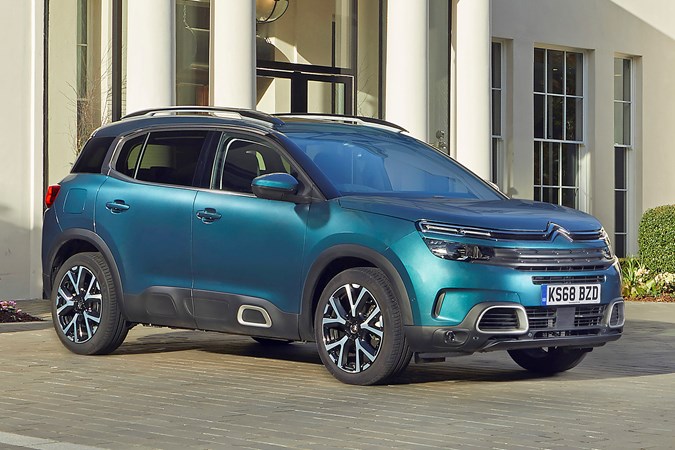
Cheapest in that line-up is the mid-range Flair, with the 130hp 1.2-litre petrol engine and the eight-speed automatic. Mileage allowance has jumped to a more useful 10,000 per year, the £199 processing fee remains static, as does the £1,750 deposit, but the term is just 24 months.
Those all important monthly payments? Just £197 – that’s an £888 saving over the cheapest Berlingo over the first two years.
Making the comparison to our long-term Berlingo a little more direct involves upping the C5 Aircross ante to Flair Plus trim and opting for the 2.0-litre 180hp BlueHDi diesel.
With the term, mileage allowance and processing fee all identical, the C5 Aircross’s initial payment is £2,250, while the monthlies are £314. Over four years the Berlingo will cost £1,162 less.
Leasing conclusions
So, what have we learned? Well, that right now, that SEAT Tarraco remains a very attractive offer, primarily, knocking most alternatives into the proverbial cocked hat.
Sticking closer to home, cheaper Berlingos may well be bristling with space and flexibility, but it’s hard to ignore how relatively inexpensive that mid-spec C5 Aircross is.
But, providing you can stretch the budget to nearly £300 per month, the higher-spec Citroen is better value for money than its most immediate rivals, barring the Peugeot Rifter. Personally, I’d stomach the extra fiver a month as I prefer the Berlingo’s looks over the Rifter.
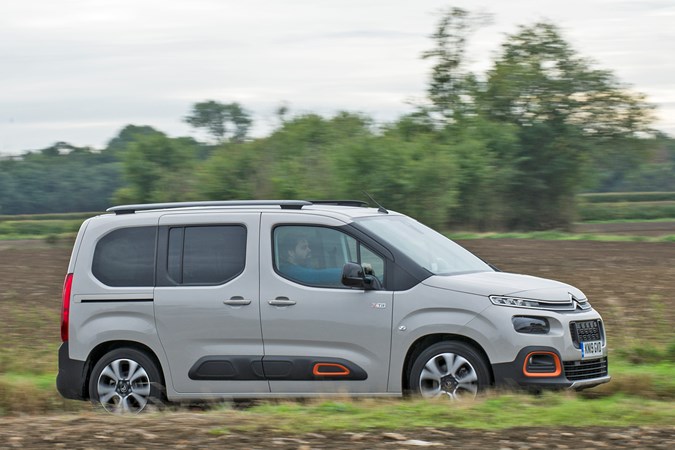
As always with car finance, it’s vital to do your homework and shop around before committing to a deal.
And that post-war research I was delving into? Citroen’s sole model in the UK post-war was the Light Fifteen – often referred to as the Traction Avant and known as Inspector Maigret’s choice of transport. Ordering one in 1945 would have set you back £573 3s 11d – about £25,000 today.
Mileage: 8,416 miles
Fuel economy: 42.4mpg
As ever with finance, there’s always small print, and here it is:
These deals are indicative examples of some packages available as at 11 May 2020, but are subject to change without prior notice. Everyone’s financial circumstances are different and the availability of credit is subject to status. Terms, conditions and exclusions apply. Parkers cannot recommend a deal for you specifically.
Bauer Consumer Media Limited is an appointed representative of ZenAuto Limited for the broking of regulated consumer hire agreements. ZenAuto Limited is authorised and regulated by the Financial Conduct Authority. ZenAuto Limited’s registered office is Number One, Great Exhibition Way, Kirkstall Forge, Leeds LS5 3BF. ZenAuto Limited’s company registration number is 10967345. ZenAuto is the trading name of ZenAuto Limited.


